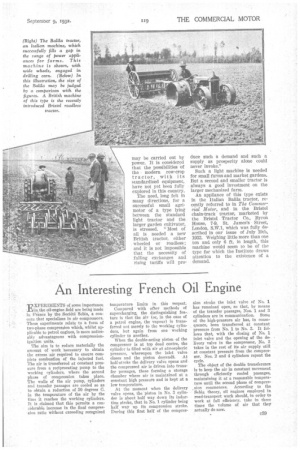An Interesting French Oil Engine
Page 61

If you've noticed an error in this article please click here to report it so we can fix it.
EXPERINIE:%.:TS of some importance ' in the oil-engine field are being made in Prance by the Societe Sebia, a concern that specialises in air compressors. These experiments relate to a form of two-phase compression which, whilst applicable to petrol engines, is more noticeably advantageous with compressionignition units.
The aim is to reduce materially the amount of work -necessary to obtain the excess air required to ensure complete combustion of the injected fuel. The air is transferred at constant pressure from a reciprocating pump to the working cylinders, where the second phase of compression takes place. The walls of the air pump, cylinders and transfer passages are cooled so as to obtain a reduction of 50 degrees (Ti. in the temperature of the air by the time it reaches the working cylinders. It is claimed that this permits a considerable increase in the final compression ratio without exceeding recognised
temperature limits in this respect.
Compared with other methods of supercharging, the distinguishing fea-, ture is that the air (or, in the case of a petrol engine, the vapour) is transferred not merely to the working cylinders, but again from one working cylinder to another.
When the double-acting piston of the compressor is at top dead centre, the cylinder is filled with air at atmospheric pressure, whereupon the inlet valve
closes and the piston descend§. At half-stroke the delivery valve opens and the compressed air is driven into transfer passages, these forming a storage chamber where air is maintained at a constant high pressure and is kept at a low temperature.
At the moment when the delivery valve opens, the piston in No. 3 cylinder is about half way down its induction stroke, that in No. 1 cylinder being half way up its compression stroke. During this first half of the compres sion stroke the inlet valve of No. 1 has remained open, so that, by means of the transfer passages, Nos. 1 and 3 cylinders are in communication. Some of the high-pressure air has, in consequenee, been transferred at constant pressure from No. 1 to No. 3. It follows that, with the closing of No. 1 inlet valve and the opening af the delivery valve in the compressor, No. 3 takes in the rest of its air supply still at constant pressure from the compressor. Nos. 2 and 4 cylinders repeat the cycle.
The object of the double transference is to keep the air in constant movement through efficiently cooled passages, maintaining it at a reasonable temperature until the second phase of compression commences. According to the Sebia theory, oil engines employed in road-transport work should, in order to work at full efficiency, take in three times the volume of air that they actually do now.












































































































